Essential Guide to Choosing Parakeet Cages
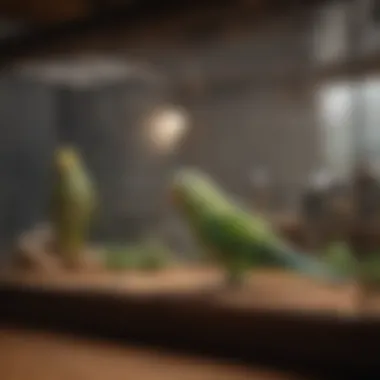
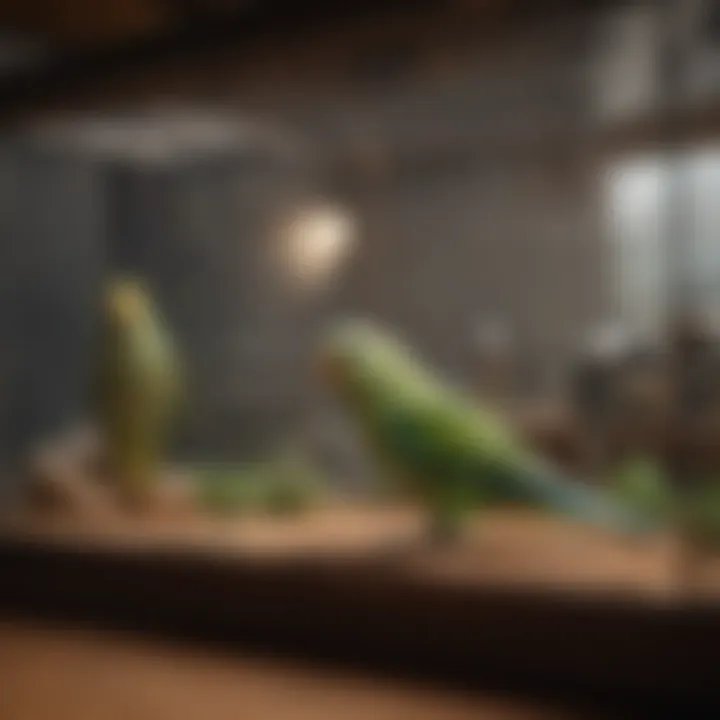
Intro
Choosing the right house cage for your parakeet can feel like an uphill battle, especially for first-time bird owners. With a myriad of options out there, it's easy to get lost in a sea of choices. This guide aims to cut through the noise – no fluff, just facts. Every detail you consider, from dimensions to material, plays a crucial part in your parakeet's happiness and health.
A well-chosen cage is more than just a means of confinement; it acts as their sanctuary, their castle, and in many ways, their entire world. Caring for them involves understanding not only their physical needs but their emotional ones as well. If you're on the journey of selecting or upgrading your parakeet's home, you've landed in the right spot.
We'll explore the essentials of cage care, behavioral insights, nutrition, wellness, and activities designed to keep your feathered friends vibrant and active. So, buckle up as we dive into this extensive exploration of all things parakeet cages, armed with substantial insights to help you foster a deeper bond with your avian companion.
Care Tips
Maintaining your parakeet's environment is foundational to their well-being. Routine care touches on everything from daily check-ins to seasonal adjustments.
Daily Care Routines
Start your day by greeting your feathered friend. This is more than just a formality; it’s about establishing a routine that reassures them you’re around. Spend a few minutes interacting with them outside the cage, whether through gentle talk or light play. After, observe the cage for any droppings or signs of damage to ensure their space remains clean and secure.
Feeding should follow a consistent schedule. Fresh food and water should be provided daily. Parakeets thrive on routine, and your consistency builds trust.
Cage Setup and Maintenance
Setting up the cage correctly is vital for your parakeet's comfort. A spacious, well-structured cage equipped with perches, toys, and food bowls creates an inviting atmosphere. Look for cages with horizontal bars for easy climbing. The placement of the cage also matters; parakeets appreciate social interaction but can be stressed by chaos. Consider placing it in a quieter corner of the room where they can still feel included.
Hygiene and Cleaning Practices
Cleaning routines are essential to preventing illness. A quick daily clean-up of food remnants and droppings is good practice. On a weekly basis, wipe down surfaces and rotate out toys for sanitation. For a more thorough monthly clean, disassemble the cage to give it a good scrub using bird-safe cleaners, making sure any residue is well rinsed away.
Seasonal Care Adjustments
As seasons change, so do your parakeet's needs. In winter, ensure the cage is away from drafts and provide extra warmth with a cozy cover, while in summer, you might need to consider the cage's positioning regarding sunlight. Monitoring temperature changes will keep them comfortable year-round.
Behavioral Insights
Understanding parakeet behavior can significantly enhance your relationship with them. These little creatures are expressive, and learning their body language will deepen your bond.
Understanding Bird Body Language
Watching for subtle shifts in posture or vocalization can tell you a lot about your parakeet's mood. Fluffing feathers might indicate they’re cold or feeling threatened, while a calm stance usually signifies comfort.
Common Behavioral Issues and Solutions
Issues like excessive screeching or feather plucking might occur if a parakeet feels neglected or stressed. Addressing these behaviours might involve more interactive playtime or more stimulating environments. It’s crucial to match their energy with fun and enriching experiences.
Positive Reinforcement Techniques
Using treats to reward good behavior goes a long way. If they do something you admire, like trying a new toy, applaud them with a small treat. This method encourages them to repeat desirable actions while bringing you closer together.
Social Interaction Needs
Parakeets are inherently social creatures, often best kept in pairs or groups. Ensure they receive adequate social interaction, both with you and other birds if possible. Too much isolation can lead to problems, so be attentive to their need for companionship.
Nutrition Guides
A balanced diet is pivotal to your parakeet's health. It not only affects their physical state but also their behavioral tendencies.
Essential Diet Components
Seeds are a common staple in a parakeet's diet, but they should not be the only component. Pellets designed specifically for parakeets often provide a more balanced nutritional profile. Additionally, incorporating fresh vegetables and fruits offers variety to bite and enriches their diet.
Safe and Toxic Foods
Certain foods can be hazardous. Items like avocado, chocolate, and caffeine are toxic to birds. Familiarizing yourself with safe versus dangerous foods can prevent accidents and keep them healthy.
Supplements and Treats
Occasional treats, often in the form of specialty seeds or fresh fruits, can be rewarding for your parakeet. However, these should be given in moderation to avoid dietary imbalances. Consider consulting your vet for recommendations tailored to your specific breed.
Feeding Strategies for Different Species
Not all parakeets are created equal; different species have varying dietary needs. Make an effort to research what your parakeet’s particular type thrives on to ensure optimal health.
Wellness and Health
Regular health checks can catch potential issues early. Keep an eye out for any odd behavior, as it might indicate underlying health problems.
Routine Health Checkups
Try to schedule annual vet visits. These check-ups often include vaccinations and assessments that catch issues before they escalate.
Identifying Symptoms of Illness
Symptoms can vary, but keep an eye out for changes in droppings, changes in energy levels, or unusual feather loss. Early detection is key in animal care, leading to prompt treatment.
Preventative Care and Vaccinations
Discuss with your veterinarian about necessary vaccinations. Being proactive will often save a lot of stress in the long run.
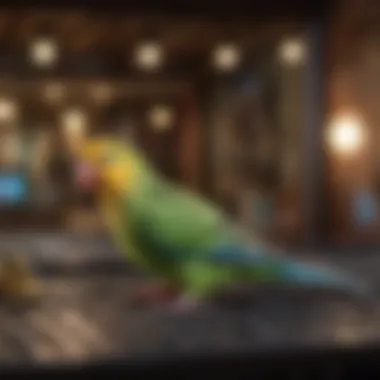
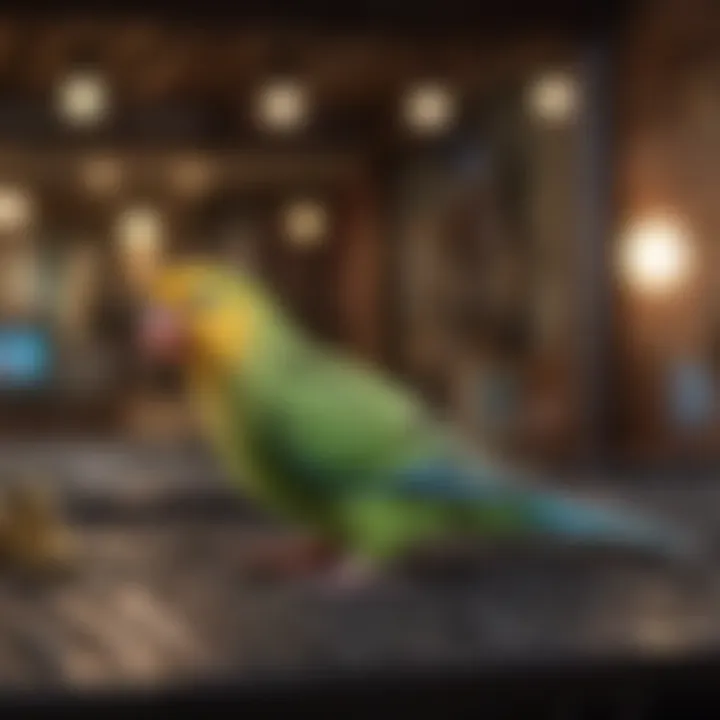
Mental and Emotional Well-being
Mental health is as important as physical health. Rotate toys often and include foraging opportunities to stimulate your parakeet's mind.
Enriching Activities
Engagement goes beyond a simple cage setup. You want to encourage healthy behaviors and keep your parakeet stimulated.
Toys and Playtime Ideas
Every bird has its preferences. Experiment with different toys, such as swings, ladders, and chew toys, to find what makes your parakeet happy.
Training and Tricks
Teaching simple tricks not only entertains but also strengthens your bond. Start simple; saying 'hello' or 'give a high-five' can be quite the accomplishment.
Outdoor Activities and Interaction
Occasionally allowing your parakeet some supervised outdoor time can provide exposure to fresh air and sunshine, beneficial for both their mood and psyche.
DIY Projects for Mental Stimulation
Creating your own toys from household items can be rewarding for you and interesting for your bird. Consider using paper towel rolls or plain boxes for them to explore.
Every interaction, from feeding to play, builds a stronger relationship with your parakeet. Treat them with care, and their affection will shine through.
Understanding Parakeet Needs
Grasping the needs of parakeets is pivotal for any prospective owner. These delightful birds thrive when their environment reflects their natural instincts and behaviors. Understanding these elements not only contributes to their well-being but also enriches the owner's experience. After all, a content parakeet enhances the vibe of any home—there’s just somethin’ about their cheerful chirping!
Natural Habitat of Parakeets
Parakeets, particularly the budgerigar variety, hail from the vast open grasslands of Australia. In their natural habitat, they roam freely in flocks, favoring areas abundant in food. The environment is characterized by a mix of shrubbery and trees where they can forage, nest, and find shelter from predators. Emulating this in a cage setting is essential. Providing ample space within a cage allows for wing flapping and climbing—essential activities for these birds. Size matters; thus, spacious cages can significantly benefit their physical and mental health.
- Key aspects of their natural habitat include:
- Open spaces for flying
- Natural perches for resting
- Availability of food sources
- Social dynamics within flocks
Social Behavior and Interaction
Social by nature, parakeets engage in complex interactions with one another. In the wild, they establish hierarchies, groom each other, and participate in various forms of vocal communication. Such dynamics amplify their need for companionship, regardless of whether it's another parakeet or interaction with humans. Owners must recognize these behaviors to nurture a positive environment.
"Birds are social creatures; they thrive on interaction and companionship both with their kind and with their human caretakers."
This interaction can be as simple as talking to them, singing, or even mimicking their sounds. The goal is to foster a feeling of safety and friendship, which not only reduces stress but enhances their overall happiness. Regular social engagement can make a significant difference in their mood and health.
Cognitive Requirements
Beyond social interaction, parakeets possess intriguing cognitive abilities. Their mental stimulation is crucial. Engaging them with challenges such as puzzles or innovative toys can prevent boredom and reduce destructive behaviors. When left without stimulation, parakeets can quickly become lethargic or develop unwanted habits such as feather plucking.
- Ways to stimulate their intellect include:
- Offering a variety of toys that promote problem-solving
- Creating opportunities for exploration in their cage
- Rotating toys regularly to maintain interest
- Engaging in training sessions, which provide both exercise and mental challenges
Recognizing and fulfilling these cognitive needs ensures they remain active and intellectually content, which translates to a happier, healthier bird. The relationship between the owner and their parakeet greatly benefits when these needs are understood and met.
Selecting the Optimal Cage
Selecting the right cage for your parakeet is a critical aspect that directly impacts their happiness and well-being. The cage serves not only as a home but also as a safe haven, where your feathered friend will spend a significant amount of their time. When considering the type of cage, various factors come into play, each with its own set of benefits. From size to material and design, every element must cater to the unique needs and behaviors of parakeets.
Choosing an appropriate cage encourages natural behaviors, promotes physical health, and reduces stress levels for your pet. An optimal cage supports their instinct to fly, climb, and explore, making it essential for both their mental and physical stimulation.
Cage Size Overview
The size of the cage is fundamental to the overall well-being of your parakeet. A cramped space can lead to behavioral issues and health problems, while a spacious cage invites activity and play. It's widely recommended that your cage should be large enough for your parakeet to stretch its wings and move around freely. Ideally, for a single parakeet, a cage of at least 18 x 18 x 24 inches is suggested. However, if you plan to house multiple birds, you should increase the dimensions to accommodate them comfortably.
Key Points on Cage Size:
- Horizontal Space: Parakeets enjoy flying horizontally. Ensure there's enough length in the cage to accommodate this.
- Height Matters: If the cage is tall, include perches at varying heights to promote climbing.
- Explore Options: Invest in a flight cage if you can, as it is designed specifically for the needs of birds, providing ample room for exercise.
Material Considerations
The material of the cage is another pivotal factor. Most cages are made from metals or stainless steel, which are durable and easy to clean. Avoid cages with toxic coatings; some painted or plated surfaces can be harmful to birds. Ensure the metal used is not only sturdy but also does not rust over time. A great choice is powder-coated metal, which can resist wear better than cheap painted options.
Best Materials to Consider:
- Stainless Steel: Highly durable and non-toxic.
- Powder-Coated Metal: Offers a good level of safety and durability.
- Plastic: Useful for certain parts but not typically for the entire cage. It's lightweight and easy to clean but ensure it’s high-grade.
Bar Spacing and Design Elements
The spacing between bars is crucial for safety. Bars that are too far apart can allow your parakeet to escape or cause injury. Generally, a bar spacing of ½ to ¾ inches is sufficient for parakeets. This prevents any small birds from squeezing through while providing enough room for them to enjoy their environment.
In terms of design elements, consider cages with rounded corners, multiple doors for easy access, and tray bottoms for convenient cleaning. Avoid cages with pointed edges or sharp materials, as these can present dangers to curious parakeets.
Design Considerations:
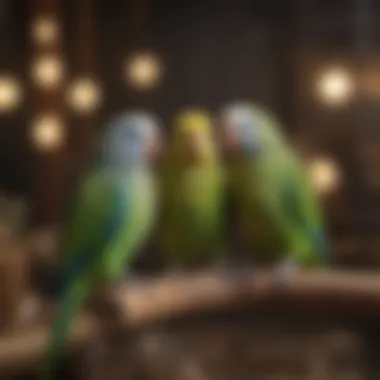
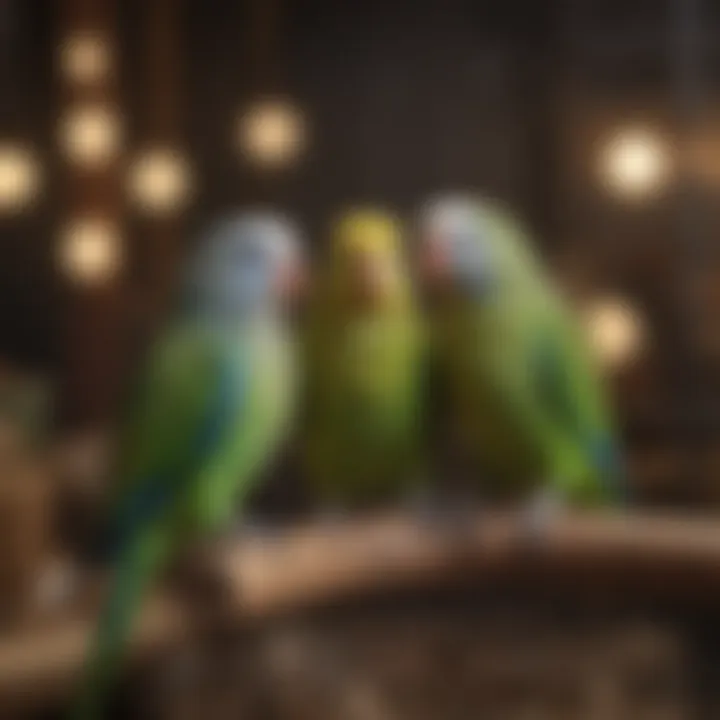
- Multiple Doors: For easier access to your bird and to make cleaning a breeze.
- Quick-Remove Trays: Helps facilitate simpler cleaning.
- Perch Placement: Ensure it allows for both resting and playing without obstructing movement.
The right cage is not merely a box; it's an ecosystem fostering the daily activities of your parakeet.
Ultimately, selecting the optimal cage can significantly influence your parakeet's quality of life. Investing the time to understand the importance of size, material, and design elements in the overall selection process not only enhances your pet’s environment, but also strengthens the bond you share.
Cage Accessories and Enrichment
Providing an enriching environment for parakeets is not just about selecting the right cage. The lineup of accessories within that space plays a vital role in their overall well-being. Whether you have a single parakeet or a small flock, keeping their mental and physical health in check hinges on what they have at their disposal.
Perches: Types and Placement
Perches are more than just landing pads for our feathered friends. They contribute significantly to their comfort and health. Different types of perches can cater to various needs:
- Natural Wood Perches: Often made from branches of non-toxic trees, these provide a textured surface that helps prevent foot problems. Natural variations in diameter allow for better grip and exercise of their feet.
- Sandpaper Perches: While they might seem like a good idea for keeping nails trimmed, too much exposure can lead to foot irritation. Moderation is key here.
- Plastic Perches: Easy to clean, but they can be too smooth and may lead to foot issues if overused.
When placing perches, consider the heights and distances within the cage. Varying the heights can encourage climbing, a natural behavior for parakeets. Ensure that perches are away from the food and water to minimize contamination. Different types and placements also help stimulate your parakeet mentally, encouraging them to explore their environment.
Toys for Mental Stimulation
Toys are an essential component in keeping parakeets entertained and engaged. They love to chew, climb, and interact with their environment. It’s crucial to choose toys that are safe and suitable for their size. Here are a few options:
- Chewable Toys: Made from untreated wood or safe cardboard, they satisfy their urge to gnaw while promoting good dental health.
- Foraging Toys: These require the parakeet to solve puzzles to access treats, perfect for mental stimulation.
- Swing Toys: Not only are they fun, but they also provide physical exercise.
Rotate the toys regularly to maintain novelty in the cage. Pay attention to the parakeet's preferences—some might prefer hanging swings while others enjoy shredding toys. Variety is the spice of life, after all.
Feeding Stations and Water Sources
A well-organized feeding station is crucial for your parakeet’s daily routine. The placement of food and water should provide easy access while keeping the area clean. Here are some considerations:
- Feeding Dishes: Use shallow bowls to prevent spills. Ceramic or metal options are often easier to clean than plastic. Position them towards the bottom of the cage but not directly under perches, which might become unsanitary quickly.
- Water Sources: Fresh, clean water should always be available. Use water bottles with sipper tubes or open dishes, ensuring you monitor for cleanliness regularly. If using a bottle, consider a bottle with a wider neck for ease of cleaning.
Establishing routine maintenance for feeding stations fosters a cleaner environment and encourages your parakeet’s healthy eating habits.
Remember: An enriching cage encourages natural behaviors, which leads to happier, healthier parakeets. Well-chosen accessories create not only a visually appealing home but also a sanctuary where parakeets can thrive mentally and physically.
Maintaining the Cage Environment
Maintaining a healthy cage environment is a key factor in ensuring the well-being of your parakeet. Just like any living creature, parakeets thrive in an environment that promotes their physical health, mental stimulation, and overall happiness. A well-kept cage not only provides a comfortable habitat but also helps in preventing various diseases and behavioral issues. It’s fair to say that a clean and properly managed cage reflects an owner’s commitment to the health and happiness of their feathery friend.
Daily Cleaning Routines
Daily cleaning might seem like a chore, but it’s the bread and butter of responsible bird-keeping. A clean cage goes a long way in preventing bacteria buildup and keeping your parakeet healthy. Here are a few tips to consider:
- Remove Droppings: Each morning, make it a habit to take a wet cloth or a special bird-safe cleaner to wipe away any droppings. Parakeets can be messy, and their droppings can harbor diseases if left unattended.
- Fresh Water and Food: Replace your parakeet's water daily and clean the water container to prevent slime buildup. Also, check their food supply; toss out any expired seeds or fruits that might spoil quickly.
- Spot Cleaning: Throughout the day, any food particles or debris can be wiped up. A little maintenance every day makes a big difference.
- Deep Clean Weekly: Once a week, take the time for a thorough clean. This includes removing all accessories, washing them with warm, soapy water, and rinsing them well. Don't forget to clean the cage bars and base thoroughly.
By adhering to daily cleaning routines, you ensure that your parakeet enjoys a fresh environment, which is essential for their overall well-being.
Preventing Parasites and Disease
A clean cage environment is your first line of defense against parasites and diseases, which can lead to serious health problems for your parakeet. Here’s how to stay ahead of potential invaders:
- Regular Inspection: Keep an eye out for any signs of pests such as mites or lice. If your bird is itching more than usual, it might be time for a thorough check-up.
- Sanitize Regularly: After your deep cleaning routine, use a bird-safe disinfectant to wipe down surfaces. Regular sanitation makes it less likely for any parasites to take hold.
- Quarantine New Birds: If you ever introduce a new parakeet to your household, it’s wise to have a quarantine period. This helps to prevent any potential transmission of diseases to your existing pet.
Investing time in preventing parasites means not only guarding your parakeet's health but also is a crucial part of fostering a long, happy life for your feathered friend. As the saying goes, “an ounce of prevention is worth a pound of cure.”
Humidity and Temperature Control
Understanding the humidity and temperature needs of parakeets can be somewhat tricky but is paramount to maintaining their comfort. They’re originally native to warmer climates, and mimicking these conditions can help them feel at ease. Consider these factors:
- Ideal Temperature: Parakeets generally prefer a temperature range of 65-80°F. Avoid placing the cage near drafts or direct sunlight, which might cause extreme temperature fluctuations.
- Humidity Levels: Opt for humidity levels around 40-60%. Too much or too little can lead to health issues. If you find your rooms are too dry in winter, consider a humidifier to balance the air. Conversely, if moisture in the air is high, ensure good ventilation by keeping windows open or setting a fan to circulate air safely.
- Monitor Changes: Changes in season can affect your home’s environment. During colder months, carefully observe whether your parakeet seems more lethargic or has changes in behavior, which could indicate they’re not comfortable with the space.
Maintaining appropriate humidity and temperature creates a cozy environment that fosters good health and happiness in your bird. Remember, the more you know about their needs, the better you can cater to them.
Psychological Considerations
Understanding the psychological needs of parakeets is just as important as their physical requirements. These birds are intelligent, social creatures that thrive in environments where they feel secure and engaged. Taking the time to consider their psychological well-being fosters a strong bond between the owner and the pet, ultimately leading to a happier and healthier parakeet.
Understanding Behavioral Signals
Parakeets communicate through a variety of behaviors and vocalizations. Observing these signals is crucial for discerning their moods and needs. For instance, a parakeet that sings and chirps energetically may be feeling content, while one that is quiet and sits hunched can indicate stress or discomfort. Recognizing these behaviors can help owners make necessary adjustments to the cage environment or their interaction habits. It’s a subtle dance of observation and response.
"Birds can’t just tell you what they’re feeling. You gotta pay attention to their vibes."
Here are some common behavioral signals to keep an eye on:
- Chirping: Often signifies happiness or excitement, especially during play.
- Head bobbing: This could be a sign of interest or an invitation to play.
- Feather fluffing: Can indicate relaxation, but if combined with a ruffled appearance, it might mean they feel threatened.
Creating a Safe Space
A safe and comfortable cage environment is vital for a parakeet’s mental health. When birds feel secure, they are more likely to explore, play, and interact positively with their environment and their owners. To create this space:
- Cage Location: Choose a location away from loud noises or direct drafts. This area should be calm and familiar for the parakeet.
- Covering the Cage: At night or during loud events, partially covering the cage can help the bird feel cozily secure. Just like us, they sometimes need a little quiet time.
- Hiding Spots: Include toys or natural branches that they can hide behind. This helps them feel safe when they need a break.
Encouraging Positive Interactions
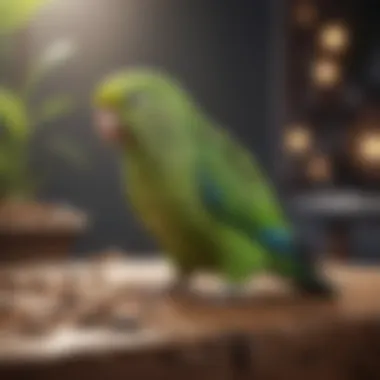
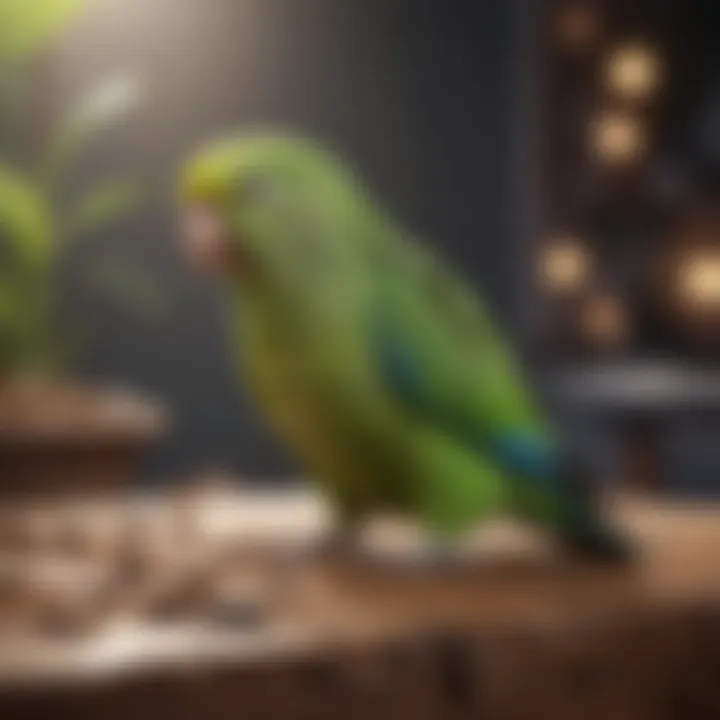
Engaging positively with one’s parakeet is not just about feeding and cleaning. It’s about building trust and forging a connection. Regular interaction helps foster a sense of security and companionship. Here are several ways to nurture positive interactions:
- Daily Routine: Consistency is key. Birds thrive on routine. Feeding them at the same times helps establish trust and dependability.
- Gentle Voice: Speaking softly to your parakeet can encourage them to bond with you. Your calm demeanor can soothe a nervous bird.
- Interactive Play: Introduce short play sessions with toys or even stepping up for some exercise. Positive reinforcement like treats for good behavior builds a rewarding experience.
Bringing all these elements together can significantly elevate the psychological welfare of parakeets. A happy parakeet not only enhances the owner’s experience but also contributes to the overall well-being of the pet. Investing effort into your feathered friend’s mental landscape will undoubtedly pay off.
Common Misconceptions
Understanding common misconceptions surrounding parakeet care helps to clear up confusion and ensure that bird owners provide the best environment for their pets. All pet owners, particularly those who are new to caring for parakeets, can easily fall prey to myths that cause them to make uninformed choices. This section aims to illuminate the more frequent fallacies that can persist among bird enthusiasts, offering insights that can enhance the well-being of these vibrant creatures.
Cage Size Myths
One of the most prevalent myths in the avian realm is the belief that smaller cages are just fine for parakeets. Many mistakenly assume that as long as the cage is clean, has food, and water, the size does not much matter. However, providing an adequately sized cage is essential for a parakeet's overall health and well-being.
Smaller cages can lead to several issues such as:
- Stress and Anxiety: In a cramped space, parakeets feel confined and may develop stress-induced behaviors such as feather plucking or aggression.
- Limited Exercise: A small cage restricts movement, hindering a parakeet’s ability to exercise, which is critical for their physical health.
The general rule of thumb is that bigger is better. Ideally, a parakeet's cage should afford enough space for the bird to spread its wings fully without touching the bars. While it’s possible to find a decent cage within small living quarters, justifying size constraints isn't wise if you can provide a more spacious environment.
“A happy bird is a healthy bird. Never underestimate the importance of space!”
Toys: Necessity versus Luxury
Many pet owners often grapple with the idea of whether toys are a luxury or a necessity for their parakeets. Some believe that their birds would be fine even without toys, citing their natural intelligence and adaptability. However, this viewpoint neglects the stimulating effect that toys have on a parakeet's psychology.
Toys play a significant role in:
- Mental Stimulation: Parakeets are among the most intelligent bird species. Without adequate stimulation, boredom can set in, leading to behavioral abnormalities.
- Destructive Behavior Prevention: Providing toys diverts their attention and keeps them engaged, minimizing potential destructive behaviors.
It's critical to incorporate a variety of toys, such as chew toys, foraging toys, and interactive ones, into the cage environment. This helps create an enriching habitat where parakeets can thrive and feel engaged—just like how humans enjoy games and puzzles.
Socialization Misbeliefs
Another key area of misunderstanding revolves around the need for socialization. Some owners assume that as long as they have one bird, there’s no need for social interaction beyond basic care routines. This misconception can actually lead to loneliness and poor mental health for a parakeet.
Parakeets are highly social animals, and they thrive on interaction not only with their caregivers but also, ideally, with other parakeets. Here are a few notes to consider:
- Boredom and Loneliness: A single bird left alone for long periods can become bored and feel lonely, leading to depression.
- Birds Watch and Learn: Interactions with humans and other birds can encourage better behaviors, as they learn what is safe and acceptable through observation.
In a scenario where owners cannot commit significant time every day, having another parakeet can be a viable solution. Two birds can engage each other, hence significantly improving each other’s quality of life.
Debunking these common misconceptions can lead to better practices in parakeet care and create an improved, flourishing environment for both the birds and their owners.
Enhancing the Owner-Pet Relationship
Enhancing the relationship between a parakeet owner and their feathered companion is not just about cohabitating; it’s about cultivating a bond that can lead to a happy, healthy life for both. When owners understand the intricacies of their parakeet's behavior, needs, and communication, they can foster an environment that supports emotional and mental well-being. This relationship lies at the heart of responsible pet ownership. By taking steps to engage meaningfully with their parrots, owners help build trust and create a fulfilling partnership.
Routine Interaction Practices
Engaging in regular interaction practices is vital for parakeets. These small birds can thrive on socialization and attention, which can significantely boost their happiness. Here are some approaches to consider:
- Daily Playtime: Aim to spend at least 30 minutes each day interacting. Whether it’s letting them out of the cage to fly around or having supervised playtime on a perch, consistency is key.
- Conversation and Sounds: Parakeets are social creatures who love to mimic sounds and words. Speak to your parakeet often. Try to engage them in lively conversations, perhaps even repeating phrases or songs. They might surprise you with their responses.
- Gentle Handling: Desensitize your pet to your presence by gently placing your hand in the cage. Let your parakeet approach you at their own pace. This movement can foster trust and comfort, which paves the way for more direct interactions later on.
Incorporating these regular interactions into your routine can lead to a more enjoyable experience for both pet and owner, allowing them to grow more accustomed to one another over time.
Training Fundamentals
Training is another essential aspect of nurturing a bond with your parakeet. Contrary to popular belief, these birds can be trained to perform tricks and respond to cues. At its core, training reinforces the owner-pet dynamic and, when done thoughtfully, can be a rewarding experience. Here are some foundational pointers:
- Positive Reinforcement: Use treats to reward desired behaviors. For example, if your parakeet steps onto your finger, offer a small piece of millet. This approach encourages your bird to repeat the behavior.
- Simple Commands: Start with basic commands such as “come here” or “step up.” Use a consistent tone and patient repetition. Over time, your bird will learn to associate commands with actions.
- Redirecting Behavior: If your parakeet displays unwanted behaviors, redirect them gently. For instance, if they start to nibble on something they shouldn’t, offer a toy instead. This method allows you to guide behavior without negativity.
Establishing a training regimen allows you to connect with your parakeet on a deeper level, ensuring they feel safe and understood amidst the learning process.
Understanding Body Language
Being attuned to a parakeet's body language is crucial for nurturing a solid relationship. Unlike humans, birds communicate significantly through their body language. Here are a few key indicators:
- Feather Position: If your parakeet’s feathers are fluffed up, they might be feeling cold or unwell. Conversely, a puffed up bird can also be comfortable, especially when resting.
- Head Bobbing: This is often a sign of excitement or desire for attention. It indicates your parakeet is feeling engaged and playful.
- Tail Movements: A rapid tail bob can signify agitated excitement, while slow movements often suggest contentment or relaxation.
To foster a positive relationship, observe these nonverbal cues and respond appropriately. Respecting your parakeet's feelings can help establish a strong foundation for mutual understanding.
Building a healthy relationship with a parakeet takes patience and time, but the joy of bonded companionship is worth every effort.
The essence of enhancing the owner-pet relationship lies in understanding, interaction, and training. These components create a fulfilling life for your feathered companion and can transform the journey of care into a shared adventure.
The End
The conclusion serves as a vital wrap-up of the important aspects discussed throughout the article. It emphasizes how the right house cage for parakeets can significantly enhance the well-being and happiness of these creatures. Selecting and maintaining an appropriate cage is not just about providing a physical space; it’s about fostering an environment that caters to their natural instincts, social behaviors, and cognitive needs. Having a suitable cage enriches their lives while promoting a strong bond between the owner and the bird.
Recap of Key Points
- Understanding Parakeet Needs: Knowing the natural habitat and social behavior of parakeets is crucial for recreating a space that feels safe and familiar to them.
- Selecting the Optimal Cage: The size, material, and design of the cage play a significant role in ensuring that the bird has enough room to move, play, and exercise.
- Cage Accessories and Enrichment: Incorporating various perches, toys, and feeding stations stimulates mental activity, ultimately leading to a healthier and happier pet.
- Maintaining the Cage Environment: Regular cleaning and a controlled environment help prevent diseases and ensure a comfortable space for your bird.
- Psychological Considerations: Understanding their behaviors and providing a safe space are foundational to a fulfilling coexistence.
- Common Misconceptions: Knowledge about cage size and the necessity of socialization is key to preventing misunderstandings about parakeet care.
- Enhancing the Owner-Pet Relationship: Routine interaction and basic training not only improve your bird's behavior but also strengthen your relationship.
Final Thoughts on Responsible Bird Keeping
Engaging in responsible bird keeping transcends just providing food and shelter; it involves a committed approach to understanding and fulfilling your parakeet's emotional and psychological needs. Being a good parakeet owner means investing time in learning about their behavior and maintaining a dynamic and stimulating environment. The journey with these feathered friends can prove immensely rewarding, as they are not just pets but companions that enrich our lives.
To foster a deeper connection with your parakeet, consider getting involved in communities that discuss bird care and training, such as reddit.com or facebook.com. The more we share and learn, the better and healthier lives our pets can lead.
Remember, every parakeet is unique, and understanding their individual needs will ultimately lead to a more harmonious living situation.
By prioritizing their happiness and well-being, parakeet owners become better equipped to nurture a lasting bond, ensuring that our avian companions thrive in their home.















